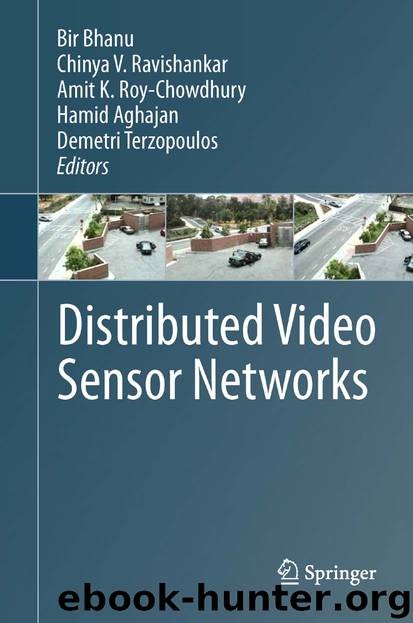Distributed Video Sensor Networks by Bir Bhanu Chinya V. Ravishankar Amit K. Roy-Chowdhury Hamid Aghajan & Demetri Terzopoulos

Author:Bir Bhanu, Chinya V. Ravishankar, Amit K. Roy-Chowdhury, Hamid Aghajan & Demetri Terzopoulos
Language: eng
Format: epub
Publisher: Springer London, London
2.3 Distributed Interaction with 2D Applications on Planar Display Walls
We have explored, for the first time, the design of a scalable interaction paradigm for rear-projected tiled displays that can scale with multiple projectors, users, applications and even interaction modalities [8, 16]. We design a SPMD distributed interaction algorithm that runs on each PPP following the distributed registration to allow multiple users to interact with the display using any kind of interaction modality.
Our method has several advantages. (a) Since we design an SPMD algorithm, it can easily scale to multiple projectors. Hence, adding and removing PPPs to reconfigure the display does not necessitate any change in the interaction algorithm. (b) Most modules of our algorithm are application independent. Hence, to adapt to different 2D applications, only a few application specific modules need to be modified. This allows our algorithm to scale to many 2D applications. (c) Similarly, changing the interaction modality requires modifying a small number of interface-dependent modules. This allows our algorithm to scale to different interaction modalities as well (e.g. laser pointers, gesture-based interface). (d) Unlike a centralized system where all the interaction from multiple users is handled by a single centralized server, a distributed algorithm distributes the load of handling multiple users to multiple PPPs. Hence, our algorithm can easily scale to multiple users.
We consider interaction to be a set of two operations that occur consecutively: (a) a 2D gesture made by the user; and (b) a consequent reaction provided by the display. We assume that a gesture is a sequence of samples, also called actions, detected by the system. These samples can be generated through a multitude of input systems including touch (e.g. by placing the palm on the screen), or laser pointers. The meanings of isolated or temporal sequences of actions are predefined by applications for consistent interpretation. Note that since a gesture occurs over an extended period of time, it can span across multiple PPPs moving between the non-overlapping and overlapping areas of the PPPs. Further, it is important that the reaction does not wait for the gesture to complete. E.g. if the user is moving his/her hands from left to right, he/she is expecting the underlying image to move from left to right even before he/she completes the gesture. Hence, the goal is to identify the gesture even when it is not complete and start reacting as soon as possible.
Our distributed interaction paradigm consists of two main components: a distributed gesture management and a distributed reaction management module. These are run as two threads in a producer-consumer fashion in each PPP (Fig. 9). The distributed gesture management module produces a queue of actions which are then processed (or consumed) by the distributed reaction manager in an FCFS manner. Note that though the user’s intentions are interpreted per gesture (which is a series of actions), the processing of these gestures is done per action. This difference in the granularity of interpretation and processing allows the system to respond to a gesture as soon as it commences without waiting for its end.
Download
This site does not store any files on its server. We only index and link to content provided by other sites. Please contact the content providers to delete copyright contents if any and email us, we'll remove relevant links or contents immediately.
Algorithms of the Intelligent Web by Haralambos Marmanis;Dmitry Babenko(8522)
Test-Driven Development with Java by Alan Mellor(7411)
Data Augmentation with Python by Duc Haba(7302)
Principles of Data Fabric by Sonia Mezzetta(7052)
Learn Blender Simulations the Right Way by Stephen Pearson(6988)
Microservices with Spring Boot 3 and Spring Cloud by Magnus Larsson(6809)
RPA Solution Architect's Handbook by Sachin Sahgal(6222)
Hadoop in Practice by Alex Holmes(6031)
The Infinite Retina by Robert Scoble Irena Cronin(5921)
Jquery UI in Action : Master the concepts Of Jquery UI: A Step By Step Approach by ANMOL GOYAL(5873)
Big Data Analysis with Python by Ivan Marin(5721)
Life 3.0: Being Human in the Age of Artificial Intelligence by Tegmark Max(5403)
Pretrain Vision and Large Language Models in Python by Emily Webber(4686)
Infrastructure as Code for Beginners by Russ McKendrick(4464)
WordPress Plugin Development Cookbook by Yannick Lefebvre(4196)
Functional Programming in JavaScript by Mantyla Dan(4124)
The Age of Surveillance Capitalism by Shoshana Zuboff(4116)
Embracing Microservices Design by Ovais Mehboob Ahmed Khan Nabil Siddiqui and Timothy Oleson(3983)
Applied Machine Learning for Healthcare and Life Sciences Using AWS by Ujjwal Ratan(3961)
